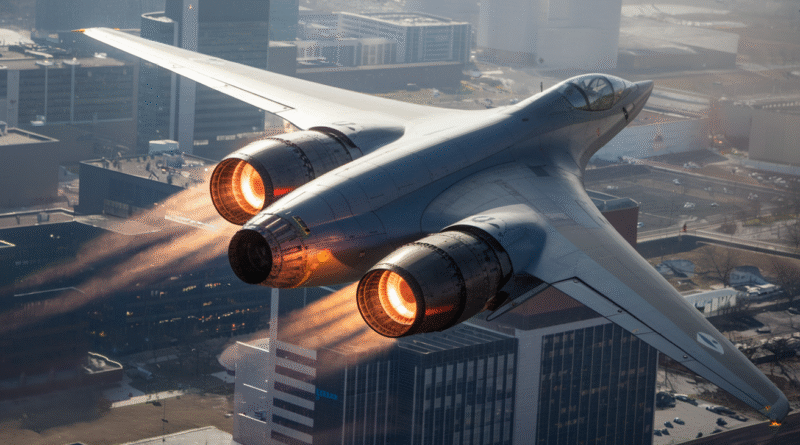The Age of Hypersonic Travel : Are We On the Verge of Commercial Supersonic Flights?
For years, the allure of supersonic travel has captured the public’s imagination, offering the potential to drastically reduce travel times across the globe. Although the Concorde’s retirement in 2003 marked the end of commercial supersonic flights, new advancements in technology are reigniting interest, with some looking beyond supersonic speeds to the realm of hypersonic travel. This raises an exciting question: Are we on the cusp of an era where crossing continents in mere hours could become routine? Let’s delve into the cutting-edge developments, the companies leading the way, and the obstacles that lie ahead.
The Evolution of Supersonic Travel
Supersonic flight—traveling faster than the speed of sound (Mach 1)—was first realized commercially in the 1970s with the Concorde. Capable of reaching Mach 2, or twice the speed of sound, it could cut travel time between New York and London to under three hours. However, Concorde faced several challenges, including high operating costs, limited range, and environmental issues. Moreover, the loud sonic booms it generated restricted its use to transoceanic routes. After nearly 30 years in operation, the Concorde was retired, and commercial supersonic travel seemed to fade into history.
Nevertheless, the desire for faster-than-sound travel persisted. Engineers have long been working on reviving and enhancing the technology, and recent breakthroughs in areas like aerodynamics, materials science, and propulsion are pushing this vision closer to reality—this time, with the potential for even faster, hypersonic speeds.
Supersonic vs. Hypersonic: What’s the Difference?
While supersonic speeds fall between Mach 1 and Mach 5, hypersonic travel refers to speeds of Mach 5 and beyond. At hypersonic velocities, the possibilities for reducing travel times expand dramatically. For example, a flight from New York to Sydney—currently over 20 hours—could potentially be completed in under two hours. However, reaching these speeds involves overcoming significant engineering and technical challenges, though current progress indicates that this once far-off concept is becoming increasingly feasible.
Companies Leading the Race
Several companies are working to bring both supersonic and hypersonic commercial travel to fruition. Some are focused on reviving supersonic flight, while others are looking to push the envelope with hypersonic technologies.
Boom Supersonic
Denver-based Boom Supersonic is at the forefront of the effort to bring back supersonic flights. Their aircraft, the Overture, is being designed to fly at Mach 1.7, reducing the flight time between New York and London to just 3.5 hours. Overture is expected to carry up to 88 passengers and reach speeds over 1,300 miles per hour. Set for a late-2020s debut, Boom has already secured orders from major airlines like United for 15 of these jets. They are also addressing one of Concorde’s key issues—noise—by aiming to reduce sonic booms and improve fuel efficiency with quieter engines.
NASA’s Quiet Supersonic Technology (Quesst) Project
NASA is working on the X-59 QueSST (Quiet Supersonic Technology) aircraft, which is designed to minimize the loud sonic booms associated with breaking the sound barrier. The goal is to enable supersonic flights over land by reducing the boom to a soft « thump. » If successful, this project could eliminate one of the major obstacles to widespread supersonic air travel.
Hermeus
Hermeus, a startup aiming to achieve hypersonic speeds, is developing the Quarterhorse aircraft, which targets Mach 5. Utilizing a turbine-based combined cycle engine, Hermeus seeks to tackle the immense heat and pressure challenges associated with these speeds. Although commercial hypersonic flight is likely still decades away, the U.S. Air Force has expressed interest in the technology, which could expedite its development for military and eventually commercial applications.
SpaceX and Starship
SpaceX, typically associated with space travel, is also a contender in this race. The company’s Starship vehicle, designed for interplanetary missions, could theoretically be repurposed for ultra-fast travel on Earth. By briefly reaching the edge of space, Starship could drastically cut the time needed to travel between distant cities—possibly to under an hour. Though still in its early stages, the idea of using space technology for rapid global travel is an intriguing possibility.
Key Challenges
Despite the exciting advancements, significant hurdles remain before supersonic and hypersonic travel becomes widely accessible.
Environmental Impact
A primary concern is the environmental footprint of supersonic travel, as it typically consumes more fuel than traditional aircraft, leading to higher emissions. Companies like Boom are exploring more fuel-efficient engines and the use of sustainable biofuels, but the environmental concerns remain, particularly for hypersonic speeds, which require significantly more energy.
Cost and Accessibility
The high cost of supersonic travel is another challenge. Concorde flights were notoriously expensive, and unless companies can find ways to lower costs, supersonic flights will likely remain a luxury service. Hypersonic travel is expected to be even more costly in its initial stages, potentially limiting its use to the ultra-wealthy, specialized industries, or military purposes. However, costs could drop over time as technology matures and more players enter the market.
Regulatory Hurdles
Regulatory restrictions, particularly regarding noise pollution from sonic booms, currently limit supersonic flights over land. NASA’s work on quiet supersonic technology could ease these restrictions, but regulatory approval is still a significant barrier. Hypersonic flights face additional safety concerns due to the extreme speeds, heat, and pressures involved, which will likely lead to stringent oversight from aviation authorities.
Technological Limitations
The extreme heat generated by air friction at hypersonic speeds requires advanced materials, such as carbon composites and titanium alloys, that can withstand temperatures exceeding 1,800°F (1,000°C). Additionally, propulsion systems that can transition between subsonic, supersonic, and hypersonic speeds are still in development, and reliability will be crucial for gaining public and regulatory trust.
The Future of High-Speed Travel
Although significant challenges remain, the race toward commercial supersonic and hypersonic travel is gaining momentum. If companies like Boom, Hermeus, and NASA succeed, we could see the first return of supersonic flights within this decade, with hypersonic travel possibly emerging in the future.
The dream of crossing continents in just a few hours is becoming more tangible, with ongoing technological advancements and growing demand for faster travel. However, the road ahead requires careful consideration of environmental, economic, and regulatory factors. If these challenges can be met, we could witness a new era of global connectivity, transforming the way we experience travel. For now, the future of high-speed flight is closer than ever.

